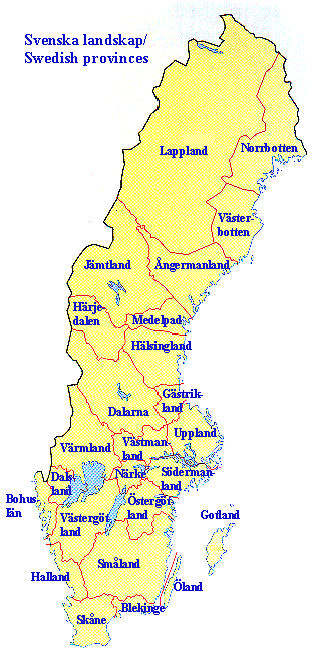Blekinge, province
in the south of Sweden; area 2,941 km2, population 151,414
(1999).
Blekinge is bounded in the south and in the east by the Baltic Sea, in the
north by the province of Småland and in the west by the province of Skåne.
It is the second smallest Swedish province, after Öland. The area of the
province is identical to the one of the county of Blekinge.
When the border lines between Denmark and Sweden was
drawn during the Viking Age Blekinge fell into Danish hands. Blekinge
has been battleground for many wars between Sweden and Denmark.
Blekinge was ceded to Sweden by Denmark in 1658 accordingly to the peace
treaty of Roskilde after the Swedish-Danish war 1657 - 1658.
Major cities: Karlskrona and Karlshamn.
The province escutcheon is a golden oak on a blue setting. The oak is also the province tree of Blekinge and mullein the province flower.

Bohuslän, province
of the Swedish west coast, area 4,473 km2, population 262,138
(1999).
The province stretches 160 km from the Norwegian border down to the city
of Gothenburg. It is a narrow province only 40 km at its widest place.
Bohuslän is bounded in the west by the Skagerrak Sea, in the east by the
provinces of Dalsland and Västergötland, in the south to Gotheburg and in
the north to Norway. The River Göta forms a natural border to Västergötland.
Within the province there are 3,000 islands and 4,500 islets and skerries.
Bohuslän first belonged to Denmark but was ceded to Sweden in 1658
accordingly to the peace treaty of Roskilde after the Swedish-Danish war
1657 - 1658.
Major cities: Uddevalla and Strömstad.
The province escutcheon is a red fortress with two golden gates encircled by a blue lion and a blue sword. The province flower is the honeysuckle and the harbor seal (knubbsäl) is the province animal.
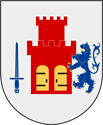
Dalarna, province in the western parts of central Sweden, area 29,086 km2,
population 283,328 (1999).
It extends from the Norwegian border in the west nearly to the town of
Gävle, in the Gulf of Bothnia in the east. Dalarna is bounded in the west by
the Norway, in the north by the province of Härjedalen, in the south by the
provinces of Västmanland and Värmland and in the east by the provinces of
Hälsingland and Gästrikland.
The area of the province is more or less identical to the one of the
county of Dalarna. The northern and western parts of the province is
mountain areas with a lot of ski resorts.
The province is often referred to as the province of Dalecarlia in
articles written in English.
Major cities: Falun and Borlänge.
The province escutcheon is two crossed arrows . The province flower is the "ängsklocka" and the eagle owl or the great horned owl (US) (berguv) is the province animal.

Dalsland, province
in the northwestern parts of the region of Götaland, area 3,708 km2,
population 53,958 (1999).
It is bounded to the east by Lake Vänern, to the west by Norway and the
province of Bohuslän, to the north by the province of Värmland and to the
south by the province of Västergötland.
Dalsland is one of the smaller provinces in the country. It is only 99 km
from north to south and 59 km from west to east.
Major city: Åmål.
The province escutcheon is a heraldic bull . The province flower is the forget-me-not and the raven (korp) is the province animal.
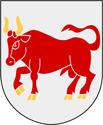
Gotland, island and
a province in the southeastern parts of Sweden, area 3,140 km2,
population 57,643 (1999). There is about 100 km from the island of Gotland
to the main land of Sweden. The province of Gotland is coextensive with the
county of Gotland. Besides the major island of Gotland there are a few other
larger and smaller islands belonging to the province; Fårö, Gotska Sandön,
Stora Karlsö and. Lilla Karlsö. Gotland stretches 125 km from north to south
and 52 km from east to west.
Gotland is a seaside resort and its population increases many times during
summer.
The major city is Visby.
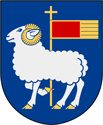
Gästrikland, province in the southern parts of the region of Norrland,
area 4,181 km2
(1,614 sq. miles), population 144,673 (1999).
Gästrikland is bounded in the south by the province of Uppland, in the
west by the provinces of Västmanland and Dalarna, in the north the province
of Hälsingland and in the east by the Gulf of Bothnia and the Baltic Sea.
Gästrikland is a forest province, 75% of its area is covered by forest.
Evergreens is the dominating type of trees.
Major cities: Gävle and Sandviken.
The province escutcheon is an elk (US: moose). The province flower is the lily of the valley and the capercaillie (tjäder) is the province animal.

Halland, province
in the southwestern parts of Sweden, area 4,786 km2, population
278,077 (1999).
Halland is bounded in the south by the province of Skåne, in the east by
the provinces of Småland and Västergötland, in the north by the province of
Västergötland and in the west by the Cattegat Sea.
The province of Halland is in large coextensive with the county of
Halland.
In the 12th century Halland belonged to Denmark. Denmark ceded Halland to
Sweden for 30 years in the peace treaty of Brömsebro in1645. However,
Halland permanently became Swedish territory in the peace treaty of Roskilde
after the Swedish-Danish war 1657 - 1658.
Major cities: Halmstad and Varberg.
The province escutcheon is an upraised silver lion on a blue setting. The province flower is the hairy greenweed and the salmon (lax) is the province animal.
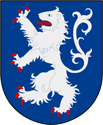
Hälsingland, province in the southern parts of the region of Norrland,
area 14,264 km2 (5,507 sq. miles),
population 138,264 (1999).
Hälsingland is bounded in the south by the province of Gästrikland, in the
west by the provinces of Dalarna and Härjedalen, in the north the province
of Medelpad and in the east by the Gulf of Bothnia.
Major cities: Hudiksvall, Söderhamn and Bollnäs.
Hälsingland is a forest province, 83% of its area is covered by forest. Evergreens is the dominating type of trees, primarily spruce and pine.
The province escutcheon is a he-goat. The province flower is the flax flower (linblomma) and the lynx (lo) is the province animal.
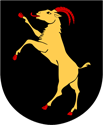
Härjedalen, province in the southwestern parts of the region of
Norrland, area 11,954 km2 (4,615 sq. miles), population
10,895 (1999).
Härjedalen is bounded in the south by the province of Dalarna, in the west
by Norway, in the north the province of Jämtland and in the east by the
provinces of Hälsingland and Medelpad.
Mountains and forests characterize Härjedalen
and there are a lot of ski resorts in the province.
During the Danish-Norwegian period Härjedalen
belonged to the Nidaros archbishop's diocese in Norway. Around 1450
Härjedalen was under Swedish rule.
Denmark ceded Härjedalen to Sweden in the peace of Brömsebro in1645.
The province escutcheon is tools for iron ore work. The province flower is the pasque-flower (mosippa) and the bear (björn) is the province animal.
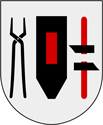
Jämtland, province in the western parts of the region of Norrland, area
34,009 km2, population 115,690 (1999).
Jämtland is bounded in the south by the province of Härjedalen, in the
west by Norway, in the north the province of Lappland and in the east by the
provinces of Medelpad and Ångermanland.
The province is by large a mountain province with a lot of ski resorts of
which Åre is one of the best in Sweden. The land rises in the west to 1,762
m (5,780 ft) but falls to below 500 m (1,500 ft) in the east.
Jämtland is by area the second largest province in Sweden.
Major city: Östersund.
In the 12th century Jämtland belonged to Norway and later Denmark/Norway. Denmark ceded Jämtland to Sweden in the peace treaty of Brömsebro in1645.
The province escutcheon has a hunting subject with a gerfalcon and an elk (US: moose). The province flower is the "brunkulla" and the elk (älg) is the province animal.
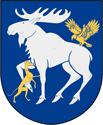
Lappland, province in the northwestern part of the region of Norrland,
area 109,702 km2 (42,356 square miles), population 106,378
(1999).
Lappland is bounded in the south by the province of Jämtland, in the west
and north by Norway, in the northwest by Finland and in the east by the
provinces of Ångermanland, Västerbotten and Norrbotten.
The province is by large a mountain region with a lot of ski resorts.
Dundret, Tärnaby, Abisko, Björkliden, and Riksgränsen are well-known
winter-sports resorts.
The highest mountains in Sweden, notably Mounts Kebne (Kebnekaise - 2,111
m (6,926 feet)) and Sarek (2,089 m (6,854 feet)) is located in Lappland.
Lappland is by area the largest province and covers about one-fourth of
the total area of Sweden, but it is sparsely settled.
Lappland is extending above the Arctic Circle.
Major city: Kiruna.
Having incorporated more than 20,669 km2 (7,980 square miles)
in 1948, Kirurna claimed to be the world's largest city in area.
The province escutcheon has a Stone-Age man. The province flower is the mountain avens (fjällsippa) and the arctic fox (fjällräv) is the province animal.
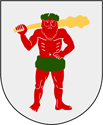
Medelpad, province in the central/eastern parts of the region of
Norrland, area 7,058 km2 (2,725 sq. miles), population
123,674 (1999).
Medelpad is bounded in the south by the province of Hälsingland, in the
west by the provinces of Härjedalen and Jämtland, in the north the province
of Ångermanland and in the east by the Gulf of Bothnia.
Medelpad is a forest province, 70% of its area
is covered by forest. Evergreens is the dominating type of trees,
primarily spruce.
Two major rivers is passing Medelpad, The River Ljungan and the
River Indalsälven.
Until the 14th century Medelpad as well as
Ångermanland was a part of the province of Hälsingland. Medelpad is
first mentioned in the sources as an independent area in 1257.
Major city: Sundsvall.
The province escutcheon has a topographical motive, two silver streams representing the two rivers of Medelpad. The province tree is the spruce (gran) and the mountain hare (skogshare) is the province animal.

Norrbotten, province in the northeastern part of the region of Norrland,
area 26,671 km2, population 197,115 (1999).
Norrbotten is bounded in the south by the province of Västerbotten, in the
west by the province of Lappland, in the northeast by Finland and in the
east by the Gulf of Bothnia.
By tradition Norrbotten has been a part of the province of Västerbotten
and not really an independent province. However, when the county of
Västerbotten was divided into two counties in 1810, Västerbotten and
Norrbotten, the part of the province of Västerbotten that resided in the new
county of Norrbotten then was regarded as an province with the same name.
Not being one of the old historical provinces of Sweden Norrbotten had not
been granted a coat of arms, an
escutcheon, in the same way as the others. As recently as
1995, after decades of controversy, Norrbotten got its arms, thus recognized
as a "real" province.
Major cities: Luleå and Piteå.
The province flower is the arctic raspberry (åkerbär) and the Siberian jay (lavskrika) is the province animal.
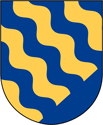
Närke, province in the central part of the region of Svealand, area
4,126 km2, population 183,406 (1999).
Närke is bounded in the southwest by the province of Västergötland, in the
northwest by the province of Värmland, in the north by province of
Västmanland, in the east by the province of Södermanland and in the
southeast by the province of Östergötland.
Major cities: Örebro and Karlskoga.
The province escutcheon has two crossed arrows and roses. The province flower is the cowslip (gullviva ) and the dormouse (hasselmus) is the province animal.
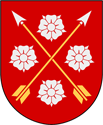
Skåne,
province in the south most part of Sweden, area 11,027 km2,
population 1,118,430 (1999).
Skåne is bounded in the north by the provinces of Halland and Småland, in
the northeast by the province of Blekinge, in the south and west the
Baltic Sea, in the west by the Sound and by the northwest by the Cattegat
Sea. The islands of Hallands Väderö and Ven also belongs to Skåne.
The province's countryside is plains.
Skåne first belonged to Denmark but was ceded to
Sweden in 1658 accordingly to the peace treaty of Roskilde after the
Swedish-Danish war 1657 - 1658. The province is often referred to as the
province of Scania in articles written in English.
Major cities: Malmö, Hälsingborg and Lund.
The Öresund Bridge (Öresundsbron) connects
Sweden and Denmark, or to be more exact the cities of Malmö in Sweden
and Copenhagen in Denmark..
The total length of the Öresund Bridge is 7.845 m (4.87 miles).
The province escutcheon has a red griffin head with a blue crown and blue beak and tongue. The province flower is the ox-eye daisy (prästkrage ) and the red deer (kronhjort) is the province animal.
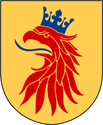
Småland, province in southern Sweden (central
part of the region of Götaland), area 29,330 km2,
population 712,029 (1999).
Småland is bounded in the north by the province of Östergötland and
by Lake Vättern, in the south by the provinces of Blekinge and
Skåne, in the west by the provinces of Västergötland and
Halland and in the east by the Baltic Sea.
Småland is a part of three different counties; the counties of
Jönköping, Kalmar and Kronoberg.
Major cities: Kalmar, Jönköping and Växjö.
Småland is a forest province. Evergreens is the dominating type of trees. The central part of the province is highland.
The province escutcheon is an upraised red lion on a golden setting. The lion is holding a red cross-bow and an arrow with a silver arrow-head in his paws. The province flower is the twinflower (linnea ) and the red otter (utter) is the province animal.
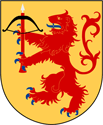
Södermanland or
Sörmland, province in the eastern part of the Svealand region ,
area 8,388 km2, population 1,062,086 (1999).
Södermanland is bounded in the north by the province of Uppland and
by Lake Mälaren, in the south by the province of Östergötland, in
the west by the province of Närke, in the northwest by the
province of Västmanland and in the east by the Baltic Sea.
The province of Södermanland is in large coextensive with the county
of Södermanland. The border line between Södermanland and Uppland is
crossing central Stockholm (through the Old Town).
Södermanland is a forest province, 65% of its
area is covered by forest. Evergreens is the dominating type of
trees.
Major cities: Nyköping, Södertälje, Strängnäs and Eskilstuna.
The province escutcheon has a griffin. A
griffin is a heraldic fabulous animal with a forepart of the body as
an eagle and the abdomen of a lion.
The province flower is the white water-lily (vit näckros) and the
fish hawk (fiskgjuse) is the province animal.
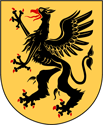
Uppland,
province in the eastern part of the Svealand region , area 12,676 km2,
population 1,290,975 (1999).
Uppland is bounded in the north by the province of Gästrikland, in
the south by the province of Södermanland and by Lake Mälaren, in
the west by the province of Västmanland and in the east by the
Baltic Sea.
The province of Uppland is in large coextensive with the county of
Uppsala. The border line between Uppland and Södermanland is
crossing central Stockholm (through the Old Town).
The northern part Uppland is a forest area
while the central and southern part are plains.
Major cities: Uppsala and Norrtälje.
The province escutcheon has a the an
golden orb on a red setting.
The province flower is the snake's head (kungsängslilja ) and the
sea-eagle (havsörn) is the province animal.

Värmland,
province in the western part of the Svealand region , area 18,204 km2,
population 319,849 (1999).
Värmland is bounded in the north by the province of Dalarna, in the
south by the provinces of Västergötland and by Dalsland, in the
southeast by Lake Vänern, in the west by Norway and in the
east by the provinces of Västmanland and Närke.
The province of Värmland is in large coextensive with the county of
Värmland.
Major cities: Karlstad, Kristinehamn and Arvika.
Värmland is a forest province, especially the northern part. About 60% of its area is covered by forest. Evergreens is the dominating type of trees.
The province escutcheon has a the an
eagle.
The province flower is the chickweed wintergreen (skogsstjärna ) and
the wolf (varg) is the province animal.
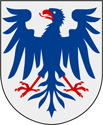
Västerbotten, province in the northeastern parts of the region of
Norrland, area 15,093 km2, population 199,910 (1999).
Västerbotten is bounded in the south by the province of Ångermanland, in
the west by the province Lappland, in the north the province of Norrbotten
and in the east by the Gulf of Bothnia and the Kvarken straits.
Major cities: Umeå and Skellefteå.
The province escutcheon has a silver reindeer. The province flower is the "kung Karls spira" and the curlew (storspov) is the province animal.
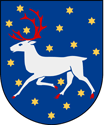
Västergötland, province in the western part of
the Götaland region , area 16,676 km2, population
1,178,268 (1999).
Västergötland is bounded in the south by the province of Halland, in
the west by the provinces of Bohuslän and Dalsland and by the
Cattegat Sea, in the north the provinces of Värmland and Närke and
by the Lake Vänern and in the east by the provinces of Östergötland,
Småland and by Lake Vättern.
Västergötland is a part of three different counties; the counties of
Västra Götaland, Halland and Örebro.
The province is a farming province with plains, especially in the
northwest.
Major cities: Göteborg, Borås and Skara.
The province escutcheon has a lion surrounded
by stars. The province flower is the heather (ljung) and the crane
(trana) is the province animal.
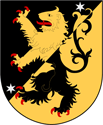
Västmanland, province in the central part of the Svealand region
, area 8,363 km2, population 284,462 (1999).
Västmanland is bounded in the south by the provinces of Södermanland
and Närke, in the west by the province of Värmland, in the north by
province of Dalarna, in the east by the province of Uppland.
The province of Västmanland is in large coextensive with the county
of Västmanland.
Major cities: Västerås and Sala.
The province escutcheon has three
mountain peaks. From each of the peaks there are flames of fire. The
province flower is the mistletoe (mistel) and the roe deer (rådjur)
is the province animal.

Ångermanland, province in the central/eastern parts of the
region of Norrland, area 19,800 km2 (7,645 sq.
miles), population 147,123 (1999).
Ångermanland is bounded in the south by the province of Medelpad, in
the west by the provinces of Jämtland and Lappland, in the north the
province of Västerbotten and in the east by the Gulf of Bothnia.
Major cities: Härnösand, Örnsköldsvik and Sollefteå.
Ångermanland is a forest province. Evergreens
is the dominating type of trees, primarily spruce.
A major rivers is passing the province, the River Ångermanälven.
Until the 14th century Medelpad as well as Ångermanland was a part of the province of Hälsingland. Ångermanland is first mentioned in the sources as an independent province in 1300's.
The province escutcheon has three
salmons.
The province flower is the love-in-idleness (styvmorsviol ) and the
beaver (bäver) is the province animal.
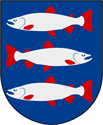
Öland, province in the eastern parts of the
region of Götaland, area 1,342 km2, population
24,937 (1999).
Öland is an island and by area the smallest province in Sweden. It
is bounded in the east by the province of Småland, surrounded by the
Baltic Sea.
The island is 135 km long and between 6 to 15 km wide. Öland is a
seaside resort and its population increases many times during
summer.
Major city: Borgholm.
The Öland Bridge connects the city of Kalmar with the town Färjestaden at Öland. The total length of the bridge is 6,072 m (3.77 miles).
The province escutcheon has a red deer.
The province flower is the "ölandssolvända" and the thrush
nightingale (näktergal) is the province animal.
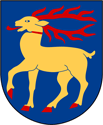
Östergötland, province in the northeastern
parts of the region of Götaland, area 9,979 km2,
population 409,600(1999).
Östergötland is bounded in the north by the provinces of
Södermanland and Närke, in the south by the province of Småland, in
the west by the province of Västergötland and by Lake Vättern
and Halland and in the east by the Baltic Sea.
The area of the province is more or less identical to the one of the
county of Östergötland.
The province has forest regions in the north as well as in the
south. In between these regions there are plains. About 60% of its
area is covered by forest. Evergreens is the dominating type of
trees.
The province escutcheon has a griffin
with wings of a dragon plus roses.
The province flower is the cornflower (blåklint ) and the mute swan
(knölsvan) is the province animal.

